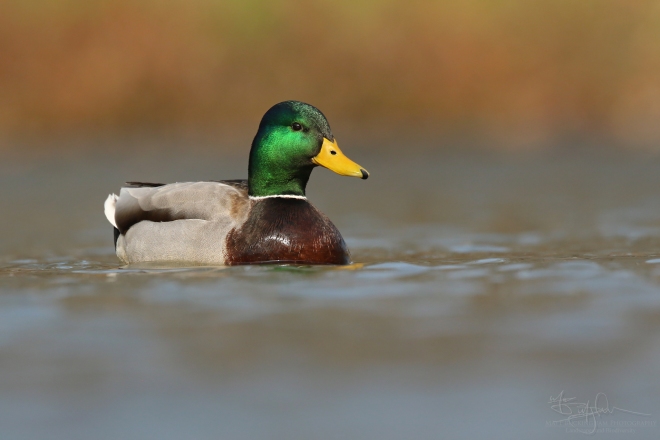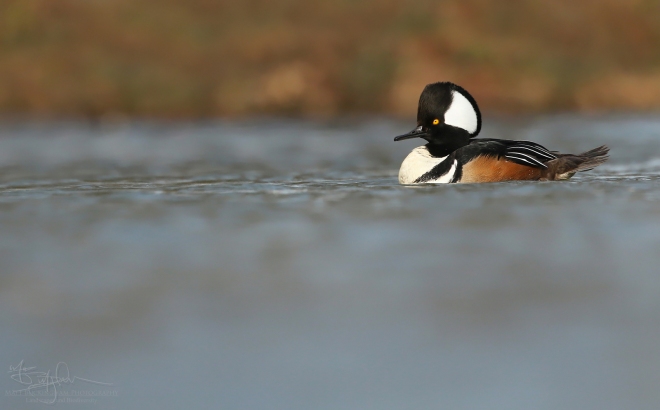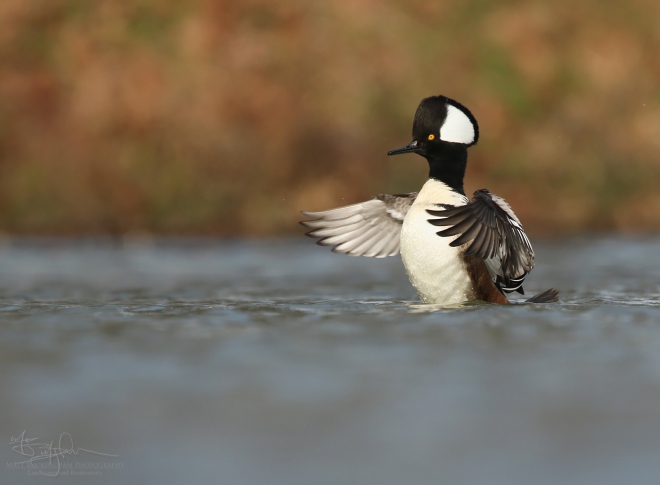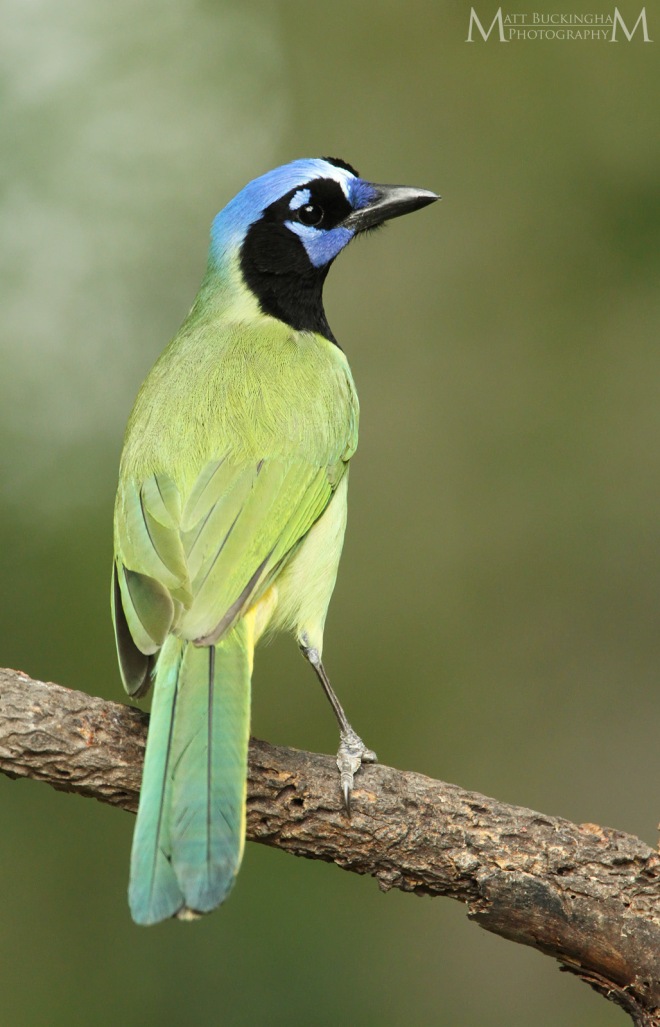
A Hooded Merganser swims through water reflecting remnant fall color in Post Oaks lining a wetland in North-Central Texas.
“Why am I doing this?” I couldn’t help but ask myself as I lay flat on my side in the muck, piles of duck feces inches from my face. I was cold and wet, and tired – so very tired. We woke up at 3:30 that morning and were on the road by 4, just so that we could arrive at our destination at first light. I had come all this way and endured all this suffering for the chance to take pictures of ducks. To many, ducks are those familiar, pesky waterbirds that harass them during a day at the park or a picnic near a pond. To me, however, they are a diverse, fascinating group of some of the most beautiful birds on the planet with incredible life histories full of harrowing journeys, dramatic performances and tales of incredible hardship. Yes, the world of ducks extends beyond the familiar Mallard and its domesticated descendants. In this blog I will explore a slice of the diversity of ducks that spend the winter in North-Central Texas.
In Texas, the northern portion of the Blackland Prairies and Cross Timbers serves as an important wintering ground for a variety of waterfowl. Wetland complexes adjacent to the Red and Trinity Rivers provide excellent habitat within a matrix of woodlands and prairies. It is also located near the boundary of the Central and Mississippi flyways. These factors help make the region a haven to ducks and geese that have traveled from as far as the Arctic Circle.
So this winter, I took three trips to the region in hopes of observing and photographing some of these beautiful birds. I researched the region extensively, looking for promising locations. We took our first trip on a grey, bitterly cold day in late December. We would end up seeing many ducks at a few different locations, but the light was not with us.
Disappointing light aside, I did leave with a few image of one of my favorite ducks, and a species I had long wanted to photograph – the Canvasback (Aythya valiseneria). With it’s long, broad black bill, characteristically sloping forehead, rusty head and bright white wings and flanks, the drake Canvasback is one of our most elegant ducks. A black bib and tail help complete its dapper plumage.
There are four basic tribes of ducks: dabbling (Anatini), diving (Aythyini), sea (Mergini), and stiff-tailed (Oxyurini) ducks. Canvasbacks are diving ducks. Members of this tribe have legs set farther back on their bodies to aid in diving. They feed by diving and foraging from the bottom of waterbodies. Canvasbacks feed heavily on underwater tubers as well as snails, mollusks, and other aquatic invertebrates. Most Canvasbacks winter in and around the Chesapeake Bay, and are generally uncommon elsewhere along the coast and inland.

Drake Canvasback

Drake Canvasback
On our next trip in early January, Caro and I were up and out hours before the sun came up. My main target for this trip was the Hooded Merganser (Lophodytes cucullatus), my favorite duck and in my opinion, one of the most beautiful birds in the country. We arrived at our first location, a forested pond in the Cross Timbers, for the day just as the sun was cresting the horizon. Sure enough, there we spotted a pair of mergansers along the distant shoreline.
I made my way to the water’s edge and lied in wait. Unfortunately, the drake never warmed up to my presence, and stayed well away. The image below is the only time he ever raised his crest, and after just a few minutes he took off and never returned.

Drake Hooded Merganser
The hen remained, however, and eventually she and the other ducks in the pond became accustomed to my presence. She swam in close and provided several nice looks at her understated plumage.

Hen Hooded Merganser
As I was admiring the merganser, a group of American Wigeon (Anas americana) flew in. I had recently photographed these stunning ducks near Austin on Christmas Day. Not one to pass up a good photo op, I captured the drake below mid-preen, as he showed off his wing coverts, scapulars, tertials, and just a hint of that iridescent speculum.

Drake American Wigeon
The sky was cloudless that day, and soon the sun was too high and the light too harsh for photography. So we grabbed lunch and traveled east, to a series of prairie ponds. Here we found a variety of ducks, including both of our Scaup species.
Scaups can be tricky to differentiate, but there are a few good characteristics to look for. Despite bearing the descriptors “Lesser” and “Greater”, size is generally not a reliable method to differentiate species, unless they are seen together.
In general, the Lesser Scaup (Aythya affinis) is smaller, however it is more readily identified by head shape and plumage detail. Lessers generally have a more raised forehead, often having a crest-like appearance with the point near the back of the head. The barring on Lesser Scaup’s feathers also extend all the way down its flanks. Other, less reliable characteristics for identification include the iridescent sheen on the head, which is generally purple in Lesser Scaups, and the black at the tip of the bill, which is generally less extensive in Lessers.
Lesser Scaups are a common winter resident on waterbodies throughout the Lonestar State. I photographed the drake below as it swam through waters reflecting the brilliant blue skies, with the muted browns of prairie grass in the background.

Lesser Scaup
Much less common a winter visitor is the Greater Scaup (Aythya marila). In Texas, they can be found sporadically along the coast in winter. Inland, they are only observed with any regularity in a small area in north-central and northeast Texas. They have journeyed here from the far north, where they breed in small ponds on the tundra and in the boreal forest.
True to their name, they are larger than Lesser Scaup, though this is only a useful diagnostic when both species are observed together. They are more reliably differentiated by their more rounded heads, pure white flanks, broader bill with more prominent black marking at the tip, and greenish sheen to the feathers on their heads.
After spending some time among the scaups, and fruitlessly stalking a Bufflehead pair, we returned home, tired but satisfied from a long day in the field.

Greater Scaup
An alternate name for this blog post could have been “My Quest for a Hooded Merganser”. Since I was a child I have been enamored with this peculiar yet spectacular sea duck. They lack the brilliant colors and iridescence of other species, but their bold black, white, and chestnut patterns along with that remarkable crest that is raised during courtship rituals sets them ahead of the pack. It also doesn’t hurt that they are one of just a few duck species to breed in forested wetlands and nest in tree cavities.
I don’t see Hooded Mergansers very often, and most sightings consist of them rapidly disappearing on the wing after having spotted me at a great distance. Though I had captured a few images on my previous visit, I wasn’t successful in getting the image I wanted – a drake with his crest raise, displaying the full glory of his breeding plumage. So despite already having made the 6-hour round trip just twice in as many weeks, I rose again before 4 AM, and hit the road to the Cross Timbers. This time I was joined by my good friend and photo buddy James Childress.
We arrived before first light, to a shallow pond nestled within a Post Oak – Cedar Elm woodland. We donned our camo and settled in, laying flat in the mud at the water’s edge. It wasn’t long before the ducks started coming in. And sure enough, we spotted a lone drake Hooded Merganser. Unfortunately he was sitting at rest, eyes barely open and crest laid flat. Much to our disappointment, he would spent most of the morning in this state.
But he was not alone. And there were plenty of other gorgeous ducks to occupy our time. One of the most striking was the Northern Shoveler (Anas clypeata). A few drakes passed by fairly closely in waters reflecting the browns of dried leaves and greens of evergreen vines lining the shore.

Northern Shoveler
I also took this opportunity to photograph a species I had long avoided, the ever present Mallard (Anas platyrhynchos). It’s not a lack of beauty that kept me from photographing them, as they are undeniably striking birds. Instead, it was the prevalence of domestic ducks, descendants of Mallards bred in captivity that have since escaped, or been released, and are now naturalized throughout much of the country. I simply have no interest in photographing feral domestic descendants, and many are virtually indistinguishable from the wild type. There are still plenty of wild Mallards in the country, however, though there are concerns that the gene pool is being diluted by these free ranging domestics. The birds we saw that day seemed to fit into the wild phenotype, and I was fairly confident and hopeful that the animals I photographed were from wild, naturally migrating populations, but there is really no way to be sure.

Mallards

Mallards
The real star of the morning however, was the American Wigeon. Some of the beautiful drakes passed close providing us with a variety of settings in which to photograph them, each better than the last. Wigeons are known for their bully-like behavior, and despite being much smaller than the Mallards, they chased them out of the best feeding grounds. In some cases they act like pirates, stealing hard-earned meals from diving ducks who, unlike the wigeons, are equipped to swim to the bottom of the pond to choose the most succulent, nutrient rich aquatic plants like Wild Celery (Vallisineria americana) We enjoyed their antics and the constantly whistle like call of the drakes.

American Wigeon

American Wigeon

American Wigeon
The sun was getting high, pushing the envelope of what I consider good light and I was beginning to worry that I would again be heading home without a decent Hooded Merganser shot. But just as we were starting to give up hope a second drake flew in. This caught the attention of our first male, and both became active, diving in search of prey, and actively preening. In the same moment a wispy veil of clouds crossed the sun, creating one of my favorite qualities of light. I captured them in some truly bizarre, yet interesting poses.

Hooded Merganser

Hooded Merganser
I captured one of the drakes as he yawned, showing of the narrow, serrated bill specially adapted for capturing fish, crustaceans, and small aquatic animals. I was certainly capturing some memorable images, but I still had failed to capture a pose with the crest raised. I missed out on two opportunities as my camera’s auto-focus failed to lock onto the subject.

Hooded Merganser
And then it happened. After a short preening session, one of the drakes raised its crest and began to really show of its spectacular plumage. It continued to preen and raise up to flap its wings and dry off its feathers. I was thrilled to check off a subject that has been on my photographic bucket list for years.

Hooded Merganser

Hooded Merganser

Hooded Merganser
While one drake was putting on a show in the distance, the other passed by close, and I was able to capture the image below in still, flat water – perhaps my favorite of the trip.

Hooded Merganser
“That’s why I’m doing this!” I thought to myself with a smile. It’s easy to lose sight of the prize while suffering in the cold and wet, and while every muscle in your body is screaming from the awkward contorted position you’ve taken up to get the perfect angle on one of the ducks. But all of the misery seems to fade away while these beautiful animals appear within range of the lens, and the suffering seems a small price to play for these images that we may enjoy and reflect on for a lifetime. I dare say, that these moments of unpleasantness only serve to enhance the experience, and I don’t think I would be rid of them, even if I could.




















